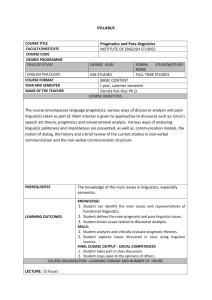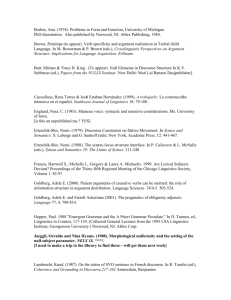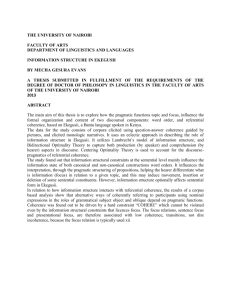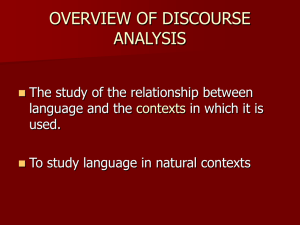CDM References
advertisement
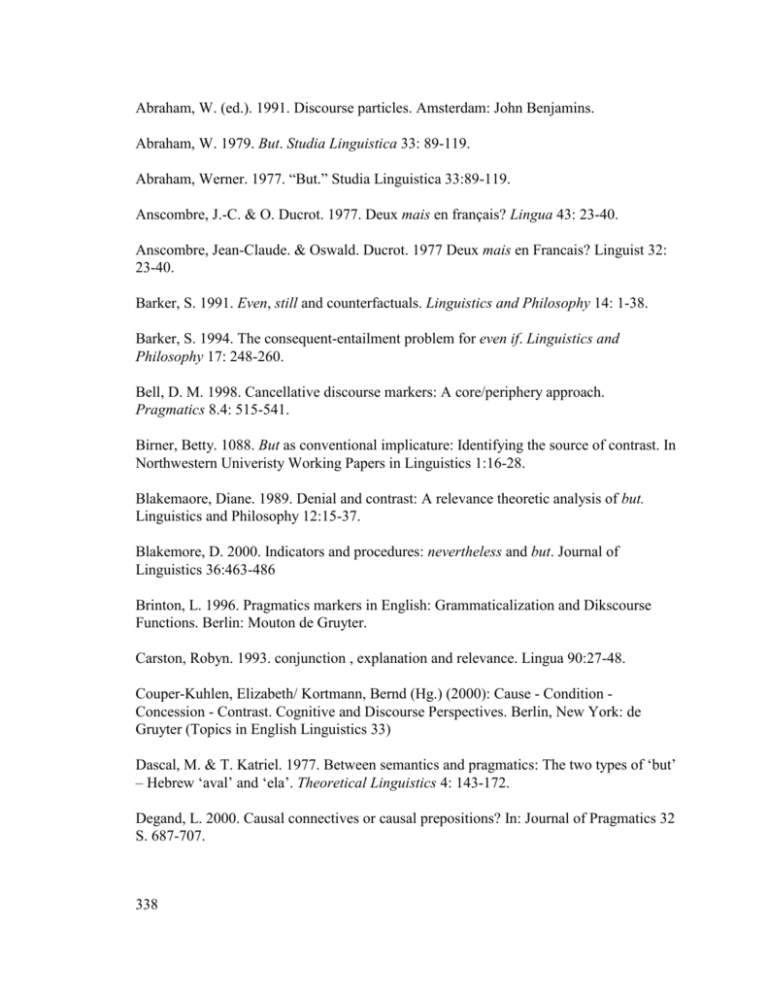
Abraham, W. (ed.). 1991. Discourse particles. Amsterdam: John Benjamins. Abraham, W. 1979. But. Studia Linguistica 33: 89-119. Abraham, Werner. 1977. “But.” Studia Linguistica 33:89-119. Anscombre, J.-C. & O. Ducrot. 1977. Deux mais en français? Lingua 43: 23-40. Anscombre, Jean-Claude. & Oswald. Ducrot. 1977 Deux mais en Francais? Linguist 32: 23-40. Barker, S. 1991. Even, still and counterfactuals. Linguistics and Philosophy 14: 1-38. Barker, S. 1994. The consequent-entailment problem for even if. Linguistics and Philosophy 17: 248-260. Bell, D. M. 1998. Cancellative discourse markers: A core/periphery approach. Pragmatics 8.4: 515-541. Birner, Betty. 1088. But as conventional implicature: Identifying the source of contrast. In Northwestern Univeristy Working Papers in Linguistics 1:16-28. Blakemaore, Diane. 1989. Denial and contrast: A relevance theoretic analysis of but. Linguistics and Philosophy 12:15-37. Blakemore, D. 2000. Indicators and procedures: nevertheless and but. Journal of Linguistics 36:463-486 Brinton, L. 1996. Pragmatics markers in English: Grammaticalization and Dikscourse Functions. Berlin: Mouton de Gruyter. Carston, Robyn. 1993. conjunction , explanation and relevance. Lingua 90:27-48. Couper-Kuhlen, Elizabeth/ Kortmann, Bernd (Hg.) (2000): Cause - Condition Concession - Contrast. Cognitive and Discourse Perspectives. Berlin, New York: de Gruyter (Topics in English Linguistics 33) Dascal, M. & T. Katriel. 1977. Between semantics and pragmatics: The two types of ‘but’ – Hebrew ‘aval’ and ‘ela’. Theoretical Linguistics 4: 143-172. Degand, L. 2000. Causal connectives or causal prepositions? In: Journal of Pragmatics 32 S. 687-707. 338 Egbe, D. 1981. Aspects of English grammar and usage. Papers in linguistics: International Journal of Human Communication 14:271-296. Eulenberg, Alexander. 1995. But revisited. Unpublished ms, U of Indiana. Fischer, K. 1998. Validating semantic analysis dof discurse partiles. JP 29:111-127. Foolen, A. 1991. Polyfunctionality and the samantics of adversative conjunctions. Multilinguia 10:79-92. Fraser, B & M. Malamud-Makowski. 1996b. “English and Spanish contrastive discourse markers” Language Sciences 8 (3-4) 863-881. Also in K. Jaszczolt & K. Turner (eds.). Contrastive Semantics and Pragmatics. Vol. II: Discourse Strategies. Oxford: Elsevier Science Ltd., 363-881. Fraser, B. 1996. Pragmatic markers. Pragmatics 6(2). Fraser, B. 1999. What are discourse markers? J of Pragmatics. Fraser, B. 2001 A View of English buts. In Festschrift for J-O Ostman. Fraser, Bruce. 1996. Pragmatic markers. Pragmatics 6(2). Fraser, Bruce. 1998. Contrastive discourse markers in English. In Discourse Markers: Descriptions and Theory edited by Jucker and Ziv. 301-326 Pragmatics and Beyond, John Benjamins. Henkemans, F Snhoeck. 1995. ‘But’ as an indicator of counter-arguments and concessions. Leuvense Bijdragen 84: Ifantidou-Trouki, E. 1993. Sentential adverbs and relevance. Lingua 90: 69-90. Iten, C. 1997. Because and although: a case of duality? UCL Working Papers in Linguistics 9: 55-76. Iten, C. 1998a. Because and although: a case of duality? In Rouchota, V. & A. H. Jucker (eds.). Current Issues in Relevance Theory. 59-80. Amsterdam: John Benjamins. Iten, C. 1998b. The meaning of although: a relevance theoretic account. UCL Working Papers in Linguistics 10: 81-108. Katriel, T. & M. Dascal. 1984 what do indicating devices indicate? Philosophy and Rhetoric 171:1-15 339 Knott, A. & T. Sanders. In press. The classification of coherence relations and their linguistic markers: an exploration of two languages. J of Pragmatics. Knott, Alistair & Ted Sanders. 1998. The classification of coherence relations and their linguistic markers: An exploration of two languages. Journal of Pragmatic. Koenig, E. 1988. Concessive connectives and concessive sentences: Cross linguistic regularities and pragmatic principles. In Explaining language universals ed. by J. Hawkins. Oxford: Basil Blackwel, Pp. 145-185. Koenig, E. 1988. concessive connectives and concessive sentences: Cross linguistic regularities and pragmatic principles. In Explaining language universals ed. by J. Hawkins. Oxford: Basil Blackwell, Pp. 145-185. König, E. 1985. On the history of concessive connectives in English. Diachronic and synchronic evidence. Lingua 66: 1-19. Lakoff, Robin. 1971. Ifs, ands and buts about conjunction. In Studies in Linguistics Semantics ed. by C. Fillmore and T. Langendoen. Holt, Reinhart & Winston, New York, 115-50. Lang, Ewald (2000): Adversative Connectors on Distinct Levels of Discourse: A Reexamination of Eve Sweetser's Three-level Approach. In: Kortmann, Bernd / CouperKuhlen, Lenk, Uta. 1998. Discourse markers and global coherence in conversation. JoP. Maat, Henk. 1998. Classifying negative coherence relations on the basis of linguistic evidence. JoP Moeschler, Jacques. 1989. Pragmatic connectives, argumentative coherence and relevance. Argumentation 3: 321-39. Oversteegen, L. 1997. On the Pragmatic Nature of Causal and Constrastive Connectives. In Spooren, W. and Risselada, R. (eds): Discourse Processes, Volume 24, Special Issue on Discourse Markers. Greenwich, Connecticut: Ablex Publishing Corporation, pp. 5185. Posner, R. 1980. Semantics and pragmatics of sentence connective in natural language. In Speech act theory and pragmatics ed. by J. Searle et.al. Reidel, 169-203. Quirk, R. et. al. 1985. A comprehensive grammar of the English language. Longman. 340 Redeker, G. 1990. Ideational and pragmatic markers of discourse structure. JP 14(3):36781. Redeker, G. 1991. Linguistic markers of discourse structure. Linguistic 29:1139-1172. Rouchota, V. 1990. ‘But’: Contradiction and relevance. UCL Working Papers in Linguistics 2: 65-81. Roulet, E. 1984. Speech acts, discourse structures, and pragmatic connectives. JP 8:3147. Rudolph, E. 1996. Contrast. Adversative and concessive relations and their expressions in English, German, Spanish, Portuguese on Sentence and Text Level. Berlin/New York: de Gruyter Rudolph, E. 1996. Contrast: Adversative and Concessive Expressions on Sentence and Text Level. Berlin: Walter de Gruyter. Salkie, R. 1996. The “all but” construction. E-mail posting, Linguistic List 7-1559. Sanders, T, Spooren W. & Noordman, L (1992) Coherence relations in a cognitive theory of discourse representations. Cognitive Linguistics. Sanders, T. 1997 Semantic and pragmatics sources of coherence: On the categorization of coherence relations in context. Discourse Processes 20. Schiffrin, D. 1987. Discourse Markers. CUP Schourup, L 1999. Discourse markers. Lingua 107: 227-265 Sidiropoulou, M. 1992. On the connective although. JP 17:210-221 Snoeck, F. 1995. “But” as an indicators of counterarguments and concessions. Leuvense Bijdragen 84. Souesme, J.-C. 1994. BUT, marqueur de passage de frontiere et ses traductions en francais. In. Sweetser, E. 1990 From etymology to pragmatics. CUP Traugott, E. 1994. UNLESS and BUT conditionals; A historical perspective. Proceedings of the Duisburg Symposium on Conditionals ed. by Angeliki Athenasiadou and Rene Dirven. Mouton de Gruyter. 341 van Dijk, T. 1979. Pragmatic connectives. JP 3: 447-456 Warner, Richard. 1985. Discourse connective in English. Garland. 342

